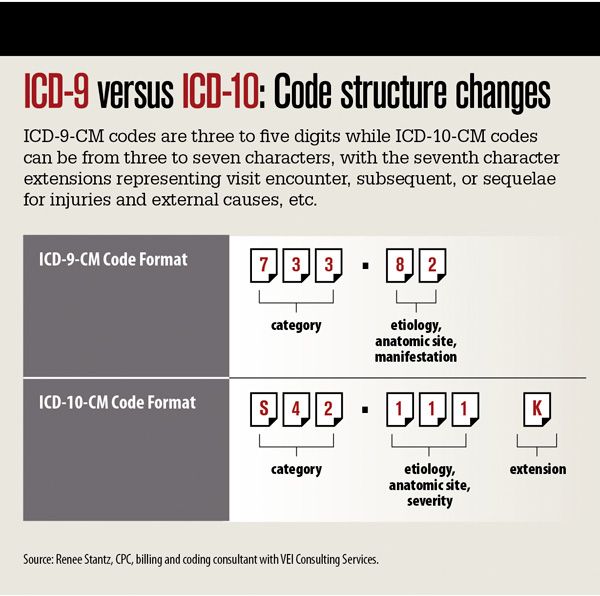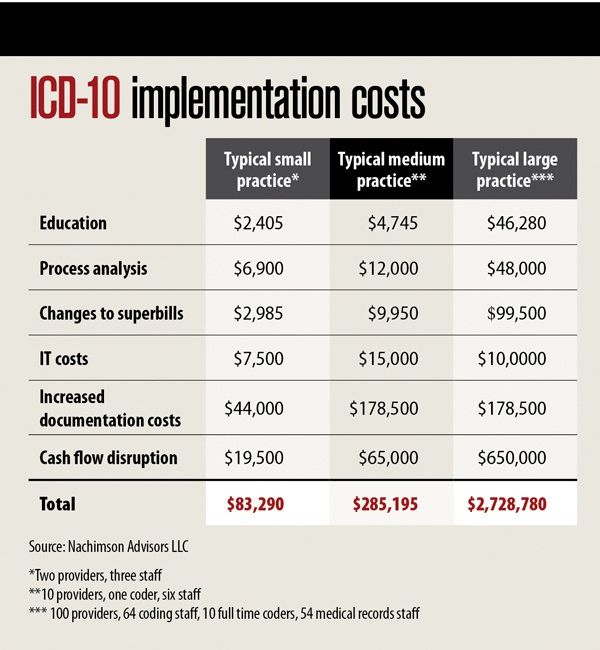Article
ICD-10 Countdown: How your practice can get ready
Author(s):
The new coding system is coming in October 2014. A lack of preparation could ultimately jeopardize your practice’s income.
“The transition to the International Classification of Diseases-10th Revision, Clinical Management coding system is more than a compliance exercise-it is a transformational event.”
In fact an Oct. 21 HIMSS/WEDI ICD-10 National Pilot Program Outcomes Report also warns that a recent test of professional coders only achieved a 63% accuracy rating when submitting ICD-10 codes.
While the transition to ICD-10 will impact everyone working in the healthcare continuum-from providers to payers and vendors-physicians have the most to lose. If claims are not submitted accurately, physicians simply won’t be paid. With less than a year until the one-day ICD-10 conversion on October 1, 2014, a physician’s ultimate life preserver is going to be planning and training, says Shari Erickson, MPH, vice president of government and regulatory affairs for the American College of Physicians.
“It’s time to kick it into gear,” Erickson says. “If you aren’t able to bill with ICD-10 codes next year, it is not just a little cut in payment. It is a 100% cut.”
Why so complicated?
ICD-10 greatly increases the specificity with which diagnoses are reported. The number of outpatient diagnostic codes will increase from around 13,000 to more than 68,000.
For medical practices, transitioning to the new coding system will require training for coders, billers, and providers in the documentation requirements, as well as changes to billing software and superbills. A 2008 study prepared by the consulting firm Nachimson Advisors LLC estimates the conversion costs will range from slightly more than $83,000 to as high as $2.7 million, depending on the size of the practice. A 2006 study prepared for America’s Heath Insurance Plans, the trade association for commercial payers, predicted the cost to the nation’s healthcare system as a whole will range from $3.2 billion to $8.3 billion.
Matthew Finneran, MD, a family medicine and geriatrics practitioner in Wadsworth, Ohio, has already started trying to get into the habit of coding with greater precision. Finneran says that preparing for the transition has made him and members of his staff pay more attention to the codes they use now. They are trying to input codes as accurately as ICD-9 allows, carrying them to the second decimal point whenever possible.
“We are making the extra effort to capture all the right codes so we can identify the complexity of visits, even though we are not getting paid for it yet,” he says.
Finneran believes that making the transition is everyone’s responsibility, which is why his entire team-which includes two full-time physicians, two part-time physicians, a nurse practitioner, and about 15 support staff-is working on understanding ICD-10 so they can help the practice’s biller/coder do her job better.
Practices that have not already gotten started on ICD-10 preparations need to get busy. “If you ignore it, you are only hurting yourself. It will be a 1-day switchover. There will be no transition. If you aren’t ready, you won’t be paid,” he says.
But since his practice is well on its way, he has another concern: Will his payers be ready? “Are they going to be able to pay me in a timely way? I have my doubts, especially Medicare. As a small practice, I don’t have a hospital to subsidize my cash flow or help me pay my employees,” he says.
Some experts are recommending that practices secure a line of credit ahead of the transition that they can draw on if a problem with the ICD-10 transition halts their cash flow temporarily. “It would be prudent to take out a credit line equal to about 5% of the total reimbursement for the year for the practice,” says Michael F. Arrigo, CPHIT, CPEMR managing partner of No World Borders, a healthcare management and information technology consulting firm.
However, Finneran says even that wouldn’t calm all of his fears, because credit lines have costs that he would probably have to shoulder alone.

Seize the opportunity
Arrigo encourages physicians to embrace ICD-10 as an opportunity to provide great patient care with good documentation. Don’t get frustrated by the large number of codes, he says, because you do not need to learn them all. He compares it to a dictionary: You don’t need to know all the words in it to write a book. Just know the ones you use most and look up the occasional outlier as needed.
“Physicians are highly intelligent and highly educated and are perfectly capable of understanding ICD-10. It’s actually more consistent with the patterns that physicians have been educated about than ICD-9,” Arrigo says.
There are many tools to help them, he adds. For example, their electronic health record (EHR) should have templates that can help them document conditions and comorbidities properly.
Boosting reimbursement
Arrigo says that because it will be easier for practices to document co-morbidities, ICD-10 has the potential to boost overall reimbursement. However, practices that do not document care properly may see a 1-to-4% reduction in reimbursement under ICD-10.
One way to make sure your practice doesn’t lose money after the transition is to have an external chart reviewer analyze your documentation process now to determine what changes you need to make to work better with ICD-10. Select for review 10 to 50 charts that represent a large proportion of your patient volume, ones that are for higher-dollar charges, and ones that are at higher risk of being denied, he advises.
Name a point person
If you are still getting started, one expert says that a key first step is to name a “point person” to head up the transition, says Cindy Hughes, CPC, CFPC, a family practice coder and certified ICD-10 trainer. Hughes says the practice manager or coding department manager may be the ideal person for this job, but that decision can vary based on your staffing.
“For a small practice, it will most likely be a team effort. Everyone will need to contribute in some way, but one person should be taking the lead to make sure you are staying on track,” she says. “There are a lot of good templates out there for making a plan but someone is going to have to take it and make it fit your practice.”
Next, call your vendors
Hughes says that contacting your software vendors to learn about their plans for upgrades should be your next step. “The hardest part is to keep following up with vendors,” she says.
The EHR vendors themselves are well aware of the conversion deadline and are working to update their software systems to accommodate ICD-10, says Lisa Gallagher, BSEE, CISM, vice president, technology solutions for the Healthcare Information Management and Systems Society (HIMSS). But nearly as large a challenge as the technical issues involved is the need for timely communication between vendors and physician practices.
“We are urging providers to contact their vendor to understand the rollout plan and find out what upgrades or new versions may be needed and what the timetable for making them available will be, and for the providers to plan their own resources to accommodate that.
“At the same time, we tell the vendors they need to contact every one of their customers and tell them your plan (for the conversion) so they can act accordingly,” Gallagher says.
Arrigo also advises practices to view their EHR vendor as a partner, but not to assume the vendor alone will make them ICD-10 compliant. “They can’t do it automatically by just upgrading your software and, in the end, they are not responsible for the healthcare providers’ compliance with ICD-10, the provider is,” he says. “At its core, ICD-10 is really about documenting the patient’s condition properly and the physician is the only professional licensed to diagnose, so they have to do a really good job documenting.”
Erickson says your vendors need to be setting up the systems to guide you based on your current clinical documentation language. Some vendors that serve larger practices have probably already done this, but smaller physicians need to be sure their vendors are testing claims processing for them now and can help walk them through the documentation process, she says.
“Drive them crazy to be sure they are ready for the change,” she says. “You need to know what upgrades you need, budget for them, and get them in place.”

Training
Experts agree that your staff will need training. There are many options available, but Erickson believes that your vendors are the best place to start. They can set up systems to guide you based on your current clinical documentation language. “Having the clinical documentation to help guide you through the coding is probably the most ideal situation,” she says.
Hughes suggests that practices consider sending an experienced coder to outside training, while other staff members might be able to get up to speed with less-expensive local and online resources and help from the trained coder. How much training physicians require depends on how they currently select their codes, she says. If they use a drop-down menu in an EHR, the vendor may be able to upgrade the software so that the physician only needs training in using it, she says.
However, everyone needs to at least be aware of these changes, especially if the EHR is being altered, as it may change other aspects of their work, Erickson says.
If you use coders, Arrigo recommends having them take a refresher course in anatomy and physiology relevant to your practice, because ICD-10 requires more precision and specificity. If you outsource coding, ask the vendors about their preparation for ICD-10 and insist on more than blanket reassurances that they are or will be compliant.
“Ask if they have tested their coders and ask if you can see the results of those tests,” he says. He adds that online training is available for physicians, who may not want to take a lot of time away from the office for training.
It is important for physicians and coders to realize they are partners in this transition, Arrigo says. Coders should be encouraged to return charts to physicians when they do not understand the documentation and doctors should not treat such queries as annoying. Conversely, coders should be reasonable and not expect the physician to completely change his or her documentation style. “They have to get this right together,” he says.
Hughes notes that additional training resources are available through many organizations, including the American Academy of Professional Coders, the American Health Information Management Association and the Center for Medicare and Medicaid Services.
Finally, start testing
Arrigo says the only way to know for sure if you are ready is to run some tests with ICD-10 data and see what happens. You can submit test claims now if your clearinghouse or payer(s) participate. “Start coding some charts in ICD-10 and build up some test data based on real-world scenarios in your practice,” he says. “Double coding a small subset of your charts now will show you where your problems are.”
Erickson agrees that it’s not too soon to start testing. “The sooner you can start testing the better, because then you can identify any issues and start fixing them or develop contingency plans if it looks like those issues won’t be fixed in time,” she says.





